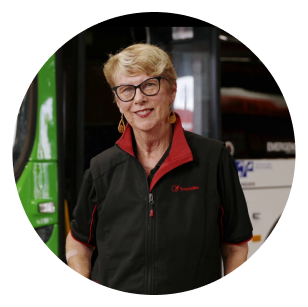

The public transport bus is Sue's office, and just like your office or workplace, there's a lot happening and she has all types of characters to deal with. Both in the bus and on the roads.
From business meetings to noisy passengers and stinky snacks, Sue's seen it all in her 34 years of driving buses and she has some simple but effective tips for you and all the other characters on our roads to help keep everyone safe.
- Never overtake a turning bus
- Giving way to merging buses is the law
- Give buses extra space to slowdown, stop & when you overtake
Australia relies on its bus drivers to get from A to B and as Sue and all other bus drivers know, it’s a big responsibility and the job can be challenging.
Whether it’s traffic congestion, timetables or passengers, bus drivers have a lot to deal with – but being patient, always allowing for extra space and making sure you’re fit to drive is a bus driver’s responsibility and your passengers' lives could depend on it.


Imagine having to babysit 30 kids… while driving a bus!
That’s just another day at the 'office' for Haru.
In the age of information, Haru's students are no class clowns and he needs to deal with everything from politics to social media.
Haru can only influence what happens on the bus and that means school bus drivers and their students depend on you to follow some simple but vital rules to help keep everyone safe.
- Give school buses extra space to slowdown, stop & when you overtake
- Always reduce your speed and take extra caution when passing a school bus with its warning lights flashing
- If a school bus has seatbelts – students must wear them!
Haru has been helping Australian students get to and from the classroom for 8 years and as Haru and all other school bus drivers know, student safety is serious BUSiness.
A school bus driver's concentration and mental health are vital to keeping our roads and students safe – so please ensure you're well rested and fit for work every shift.
Students and their families depend on you.


Self-confessed 'excellent driver' and viral comedian Jimmy Rees has joined forces with the NHVR in a bid to educate 'not so excellent drivers' on safely sharing the road with trucks! While the average driver might not spend much time considering what it means to drive safely around trucks, as a dad that likes caravanning, Jimmy knows that the truck driver POV "point of view" is key!
Taking the caravan out for a spin? Heading on the great Australian road trip? Here are some top tips when you're sharing the road with heavy vehicles, because trust us, you will be:
You must leave truck rest stops free for truck drivers! They're legally obligated to record their work and rest hours and manage their fatigue. Ensure you pre-plan your trip so that you can utilise caravan parks or caravan specific parking at service centres.
You can communicate with truck drivers through your UHF radio. Channel 40 is usually the most common for truck drivers and you can let them know that you are going to overtake or they can let you know they're going to overtake you!
When a truck is overtaking you, maintain your speed - don't slow down and do not exceed the speed limit.
I spy.... a truck's mirrors!
Yep, if you're taking the kids for a road trip you'll be all too familiar with that game and with anything that keeps them preoccupied!
Here's one for your next road trip...
I spy... a truck's four blind spots and they are:
- immediately in front of the truck
- beside the driver’s door
- directly behind the truck
- on the passenger’s side, from the door extending out across three lanes along the length of the truck
Remember, if you have to drive through these areas to pass a truck, make sure you’re far enough behind for the truck driver to see you, indicate early, and then pass as quickly as it's safe to do so without breaking the speed limit and without sitting in their blind spots!
What's that? The sound of freedom? Well.. almost. First, you need to learn how to share the road with heavy vehicles.
Disclaimer: It's important when you're learning to drive but it's equally as important when you have your licence too!
Did you now that trucks and other vehicles over 7.5 metres long that have a DO NOT OVERTAKE TURNING VEHICLE sign on the back are legally allowed to take up more than one lane to turn at corner, intersections and roundabouts.
So, whether you're turning left, right or you're at a roundabout, don't drive past or overtake a turning truck unless you're absolutely sure it's safe to do so.
Remember, if you can't see a truck's mirrors, the truck driver can't see you!


“The message is simple – we need space to keep you safe.” That’s what outback trucker Glenn “Yogi” Kendall wants motorists to know across Australia. The popular truckie from Katanning in Western Australia has joined forces with the National Heavy Vehicle Regulator (NHVR) to spread the message of heavy vehicle safety because after 26 years driving trucks on our roads – he really has seen it all.
“When I take my truck out on the road, I set out to come home safely.” – Yogi
As car motorists, we need to play our part in ensuring that Truckies can do just that.
Trucks with a ‘DO NOT OVERTAKE TURNING VEHICLE’ sign on the back are legally allowed to take up more than one lane to turn at corners, intersections and roundabouts.
They can even use a right turn only lane to turn left or at a left turn only lane to turn right. Pretty crazy right? Right turning… lane.. to.. turn left.. from the.. right side? You get it – we need space!
While Yogi says that one of the best parts about the job is driving into new places and the thrill of not knowing what’s around the corner. When it comes to blind spots, not knowing what’s around the corner is also be the worst part!
Trucks have four blind spots:
- immediately in front of the truck
- beside the driver’s door
- directly behind the truck
- on the passenger’s side, from the door extending out across three lanes along the length of the truck
“Sitting up in my cab, I worry watching other motorists make dangerous decisions because they’re unaware of what’s in front, beside or behind their vehicle.” – Yogi
And while it can be easy to become frustrated when you’re ‘stuck’ behind a truck. You need to understand – trucks are heavier, longer and bigger – so remember:
Maintain a safe following distance
That’s at least two seconds behind the truck; more if the weather’s bad or it’s dark. Staying this far back means you’re more likely to see oncoming traffic and overtaking opportunities.
Don’t linger by the truck
When it looks like it’s safe to pass, start to close the gap, then indicate and pass as quickly as possible without breaking the speed limit. If you linger by the truck, you may be in their blind spot.
Don’t cut in front of the truck
Maintain your speed and only pull back in when you can see both the truck’s headlights in your rear-view mirror.
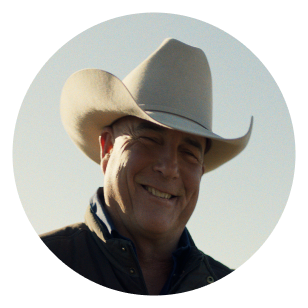

Australian country music star, James Blundell, knows what it’s like to spend hours at a time on the road. Whether it’s as a touring artist for the last 35 years or through his work on his farm at Stanthorpe – he knows how important it is to drive safely around heavy vehicles. James has teamed up with the NHVR to put a new spin on his smash hit ‘Way Out West’ to help motorists understand that We All Need Space.
Way out west where the road trains crawl
A truck’s blind spots - yeah you need to know!
A truck’s blind spots are:
- Immediately in front of the truck
- Beside the driver’s door
- Directly behind the truck
- On the passengers side, from the door extending out across three lanes along the length of the truck!
Way out west, you might see over a hundred roads trains on a single journey and when you have a motorist who doesn’t know how to share the road, that’s when things can go wrong.
If you have to drive through a truck’s blind spots to overtake, make sure you are far enough behind for the truck driver to see you, indicate early, and then pass as quickly as it’s safe to do so without breaking the speed limit and without sitting in their blind spots.
- Maintain a safe following distance
- Don’t linger by the truck
- Don’t cut in front of the truck
Also remember when a truck is overtaking YOU, maintain your speed, don’t slow down and do not exceed the speed limit.
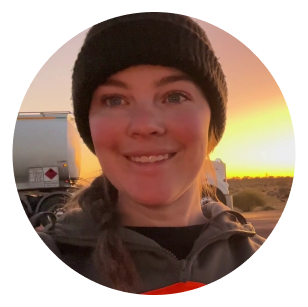

As a child, Casuarina ‘CJ’ Smith watched her father turn to driving trucks in the quiet farming season. Seeing her dad on the road inspired the 33-year-old Adelaide local to make a career as a truck driver herself. After seven years as a full-time ‘truckie’, and with an online following of tens of thousands who watch her daily travels, CJ has joined the NHVR’s We All Need Space road safety campaign, so that all truck drivers can get home safely every time they go to work.
3 tips to stay safe around trucks
“Being out on the road myself, I’m passionate about educating other motorists on how to drive responsibly around trucks.”
CJ’s top tips are:
- Don’t pull in front of a truck
- Don’t overtake a turning truck and
- Avoid truck blind spots!
A truck’s blind spots!
Trucks have four blind spots! Do you know where they are? CJ and Sonny (her very cute sidekick) are here to keep us safe by demonstrating where they are.
A truck’s blind spots are:
- Immediately in front of the truck
- Beside the driver’s door
- Directly behind the truck
- On the passengers side, from the door extending out across three lanes across the length of the truck
Oversize Loads
Oversize means they’re at least 2.5 metres wide and they take up more than half the road. That’s why they’re often accompanied by pilot or escort vehicles.
The number one rule when approaching an oversize load? Don’t panic! Slow down and wait to be shown what to do.


Being tackled on the rugby field is like being hit by a truck – only when it’s your car up against a truck – you won’t come out on top. Rugby league legend Sam Thaiday is helping the NHVR to spread this important safety message because even though on the field the opposition may not need space, on the road, trucks sure do!
On the field
It’s important to be a team player not just on the field but on the road too.
Just like Sam trucks need extra distance to slow down and brake and extra space to turn. So, get off their back and always give trucks three to four times more space than you would give a car.
In the locker room
Coach Sam takes us to the locker room to show us how important it is to share the road safely with trucks. Whether you’re driving to work, doing school drop off, or back in the day like Sam, heading to training, we all need space.
Lesson 1: Don’t overtake a turning truck.
Lesson 2: Don’t be caught offside in a truck’s blind spots!
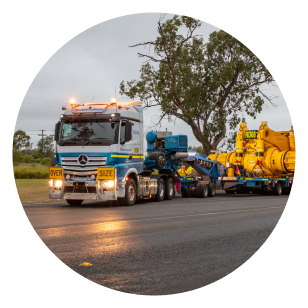

No matter where you're driving in Australia, you may come across a truck with an oversize load. It may be an old house being moved to a new location, equipment for mines or construction projects, or giant turbines for a wind farm. The National Heavy Vehicle Regulator joined forces with Centurion, the Queensland Police Service and Working iT Pilots to produce these videos. Thank you also to Ares Group, The Drone Way, ODLS and Queensland House Removers for providing additional footage of oversize load movements.
Driving safely around oversize loads
Oversize means they’re at least 2.5 metres wide and they take up more than half the road. That’s why they’re often accompanied by pilot or escort vehicles.
A pilot vehicle will always have an ‘Oversize Load Ahead’ sign and yellow flashing lights on its roof. An escort vehicle’s warning lights may be a different colour, depending on whether it’s a police vehicle or transport enforcement vehicle, and where you are in Australia. It can be a very long convoy, stretching kilometres.
But one thing‘s the same all over… what you should do when you come across an oversize vehicle on the road.
Firstly, don’t panic! Slow down and wait to be shown what to do.
Police
For approximately 30 years, Craig from Queensland Police Service has been doing escorts to ensure the safe movement of wide loads around Queensland. “The important thing is wide loads are a fact of life on our road network. Other road users need to understand that and respect the fact that they are not easy to pass on the road.”
Approaching an oversize load
- If the oversize load is coming towards you, and there’s a pilot or escort vehicle in front of it, they’ll signal to you to slow down, pull off onto the shoulder, and stop. If you have UHF radio, they may call you on Channel 40 to tell you what to do.
- Once the load has safely passed, continue on your way.
Pilot Driver
Robyn has been working as a pilot driver for 18 years and has travelled all around Australia. She shared her advice when sharing the road with oversize loads. "The consequence is you will not win against a truck like that. If you've got a radio, turn your radio on, talk to us and communicate. Be courteous and respectful and we'll all get through safely."
Following an oversize load
- If you’re driving up behind an oversize load with a pilot or escort following it, slow down, keep a safe following distance, and wait for directions.
- Only overtake when you’re signalled to do and don’t hesitate while overtaking. Pass quickly without speeding.
- If there’s no pilot or escort, only overtake unless there’s a very long, straight stretch of road and you can see clearly what’s ahead.
- Do not overtake the pilot or escort vehicle behind the load… and get stuck in between. This makes it hard for everyone to do their job safely, and you’re putting yourself and others at risk.
Truck Driver
Darren has been driving oversize loads for over 15 years, and has shared his message about sharing our roads with oversize loads: “It's extremely important to share the road with wide loads. We try and pass everyone with as much safety as we can, bringing common sense and a bit of patience so we all get home safely.”
Other important life-saving facts
- If you try and pass a wide load without getting the go-ahead from the pilot or escort, or you pull back out onto the road before the load’s safely passed, you could be pushed off the road… or worse. The truck driver may not know you’re there.
- Oversize vehicles may have to move into the middle of the road – to cross a bridge, pass under powerlines or tree branches, or avoid things at the side of the road, like guardrails, road signs and power poles.
- Also, they don’t bend! When they go round a corner, they can sweep across several lanes, so passing on corners can be extremely dangerous.
- And never cut in front of an oversize vehicle. They can’t stop suddenly.
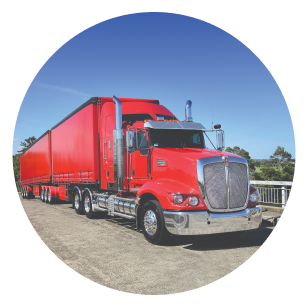

From footy fields to outback farms, and everywhere in between - Yogi, CJ, Sam, Jimmy and James are here to share their simple but effective tips to keep you and your loved ones safe these holidays.
Being on holiday is a breeze - but making sure everyone gets to and from their holiday destination safely is serious business.
With increased traffic on the roads over the Christmas holidays, the NHVR is reminding Australians how to safely share the road with heavy vehicles and make sure everyone gets to where they are going safely this holiday season.
4 simple but vital tips to keep you and your loved ones safe when sharing the road with heavy vehicles this holiday season:
- How to overtake a truck
- Where trucks blind spots are
- Trucks need more space to slow down and stop
- Caravanning etiquette around trucks
Learn more about how to share the road with heavy vehicles.
© Copyright National Heavy Vehicle Regulator 2023

 Accessibility tools
Accessibility tools

